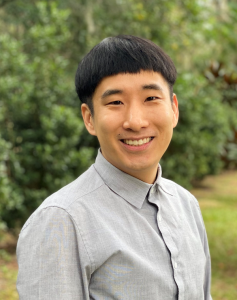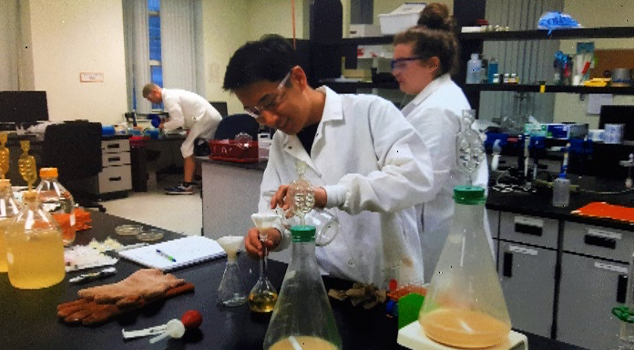 Welcome to our first installment of FSHN Research Journeys, which follows the research of graduate students in the Food Science and Human Nutrition program at UF. Today’s guest poster is Dongjoo Kim, a first-year graduate student earning his M.S. in Food Science and Human Nutrition. Read on to learn about citrus greening disease and his crucial work to support the Florida citrus industry by developing a delicious product.
Welcome to our first installment of FSHN Research Journeys, which follows the research of graduate students in the Food Science and Human Nutrition program at UF. Today’s guest poster is Dongjoo Kim, a first-year graduate student earning his M.S. in Food Science and Human Nutrition. Read on to learn about citrus greening disease and his crucial work to support the Florida citrus industry by developing a delicious product.
Dongjoo:
In 2005, something strange was happening to citrus fruits, especially to oranges in Florida. Leaves were turning yellow, but the fruits remained green at the blossom end. Unripe fruits were dropping off the trees, and the remaining fruits did not grow big enough to be harvested. An orange disaster called HLB had arrived in Florida, causing fear and frustration among orange growers across the state.
Citrus Greening Disease

Citrus greening disease, as known as huanglongbing (HLB), is a severe disease in citrus plants, particularly in sweet oranges. HLB is caused by infection of the bacterium, Candidatus Liberibacter asiaticus. A small, plant-feeding insect called the Asian citrus psyllid transmits this bacterium. While researchers have not pinpointed the origin of the disease, the increase of international trade of citrus plants led to the spread of the psyllid and bacterium to Florida.
After the discovery of HLB in Florida, the disease quickly spread throughout the commercial citrus production area. Citrus production dropped more than 60% from the 2013-14 season to 2017-18 season. Despite knowing about the disease for decades, researchers have not yet found an effective cure. One way to overcome this problem is to develop HLB-tolerant cultivars. In the midst of this critical research to help save the Florida citrus industry, I began my work with Sugar Belle, an HLB-resistant mandarin hybrid cultivar. However, my research into HLB and citrus was not my first journey into food science.
Dongjoo’s Journey to a Career in Flavors
When I was younger, I read a book called Sweets, Sweet Temptation to Hurt My Child about the hazards of processed food. It was a shock for me. After reading this book, I began to check the ingredients on food packaging. There were so many additives, but I knew about only a few of them and wondered about their uses and effects—questions that always came to mind. On these ingredient labels, the names of flavors caught my eye and inspired me to pursue a career in flavors.

In 2018, I had an opportunity to participate in the WEST program, which is sponsored by Korea and the US government. Organizers found me a place in Dr. Andrew MacIntosh’s lab at UF for an internship in food and nutrition. I interned in Dr. MacIntosh’s lab for four months. During that time, the members of the lab conducted many research projects, especially with beer and fermented peach juice beverages. This experience encouraged me to include the process of fermentation in my research project. The project reflects my passion for flavor chemistry as well as product development with health benefits.
Because of my interest in flavors, I applied to work with Dr. Yu Wang in Lake Alfred for my Master’s degree in Spring 2020. In her lab, there were ongoing experiments regarding HLB disease, including with HLB-tolerant cultivars that might be good for my project. The good memories I had from working in Dr. MacIntosh’s lab with fermentation experiments and the citrus projects in Dr. Wang’s lab inspired me to work with flavors and fermentation related to citrus.
How Kombucha Can Aid the Florida Citrus Industry

My aim is to encourage farmers to grow more Sugar Belle, the HLB-tolerant mandarin hybrid cultivar, and to explore the benefits of Sugar Belle products—for example, a Sugar Belle kombucha similar to what the one I am developing. Doing so would help to avoid damages from HLB as well as sell products that consumers would enjoy. Sugar Belle oranges can be eaten raw or made into juice. However, the fresh citrus market is relatively smaller than the citrus juice or beverage markets, so developing a variety of products can maximize usage of this cultivar.
Before I can recommend the Sugar Belle kombucha, however, I will study chemical compositions and volatile changes in particular health benefits during the fermentation process. I will also consider the consumer acceptability of the Sugar Belle kombucha so that, ultimately, I could develop a tasty beverage with health benefits. My hope is to see a difference in bioactive composition during the Sugar Belle kombucha fermentation and that this fermentation process will enhance the flavor of the kombucha.

Although a cure for HLB has not been discovered and growers are waiting for a treatment for this devastating disease, I hope the Sugar Belle cultivar will be an alternative for them to mitigate the effects of HLB and revive the citrus industry.
For more information about Citrus Greening, check out the following links:
UF/IFAS Citrus Greening publications directory
Florida Department of Agriculture and Consumer Services information page
Dongjoo Kim was born and grown in the Seoul Metropolitan area of South Korea. He majored in chemistry and food & nutrition at Hanyang University in Seoul, South Korea. He is currently working toward a Master’s degree in Food Science and Human Nutrition under the mentorship of Dr. Yu Wang in Lake Alfred. He likes cooking but is not a good cook (at least, he often tries to make something delicious, with mixed success).
 2
2
